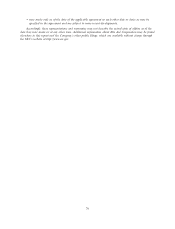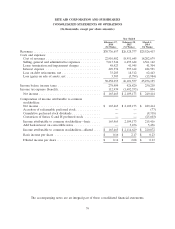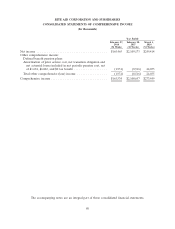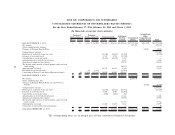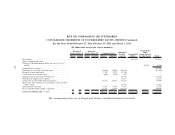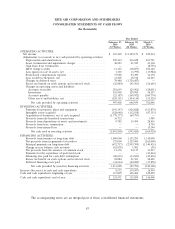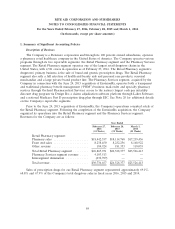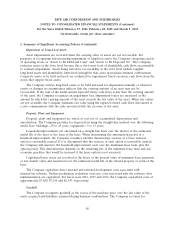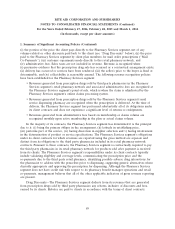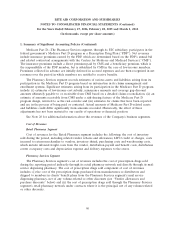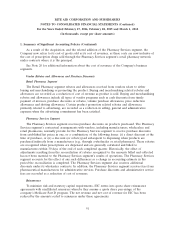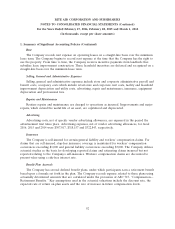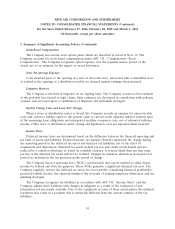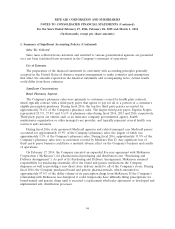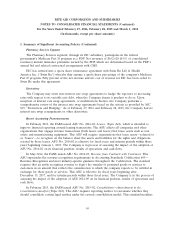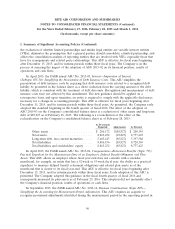Rite Aid 2016 Annual Report Download - page 86
Download and view the complete annual report
Please find page 86 of the 2016 Rite Aid annual report below. You can navigate through the pages in the report by either clicking on the pages listed below, or by using the keyword search tool below to find specific information within the annual report.RITE AID CORPORATION AND SUBSIDIARIES
NOTES TO CONSOLIDATED FINANCIAL STATEMENTS (Continued)
For the Years Ended February 27, 2016, February 28, 2015 and March 1, 2014
(In thousands, except per share amounts)
1. Summary of Significant Accounting Policies (Continued)
Impairment of Long-Lived Assets
Asset impairments are recorded when the carrying value of assets are not recoverable. For
purposes of recognizing and measuring impairment of long-lived assets, the Company categorizes assets
of operating stores as ‘‘Assets to Be Held and Used’’ and ‘‘Assets to Be Disposed Of.’’ The Company
evaluates assets at the store level because this is the lowest level of identifiable cash flows ascertainable
to evaluate impairment. Assets being tested for recoverability at the store level include tangible
long-lived assets and identifiable, finite-lived intangibles that arose in purchase business combinations.
Corporate assets to be held and used are evaluated for impairment based on excess cash flows from the
stores that support those assets.
The Company reviews long-lived assets to be held and used for impairment annually or whenever
events or changes in circumstances indicate that the carrying amount of an asset may not be
recoverable. If the sum of the undiscounted expected future cash flows is less than the carrying amount
of the asset, the Company recognizes an impairment loss. Impairment losses are measured as the
amount by which the carrying amount of the asset exceeds the fair value of the asset. When fair values
are not available, the Company estimates fair value using the expected future cash flows discounted at
a rate commensurate with the risks associated with the recovery of the asset.
Property, Plant and Equipment
Property, plant and equipment are stated at cost, net of accumulated depreciation and
amortization. The Company provides for depreciation using the straight-line method over the following
useful lives: buildings—30 to 45 years; equipment—3 to 15 years.
Leasehold improvements are amortized on a straight-line basis over the shorter of the estimated
useful life of the asset or the term of the lease. When determining the amortization period of a
leasehold improvement, the Company considers whether discretionary exercise of a lease renewal
option is reasonably assured. If it is determined that the exercise of such option is reasonably assured,
the Company will amortize the leasehold improvement asset over the minimum lease term, plus the
option period. This determination depends on the remaining life of the minimum lease term and any
economic penalties that would be incurred if the lease option is not exercised.
Capitalized lease assets are recorded at the lesser of the present value of minimum lease payments
or fair market value and amortized over the estimated useful life of the related property or term of the
lease.
The Company capitalizes direct internal and external development costs associated with
internal-use software. Neither preliminary evaluation costs nor costs associated with the software after
implementation are capitalized. For fiscal years 2016, 2015 and 2014, the Company capitalized costs of
approximately $7,680, $7,550 and $6,547, respectively.
Goodwill
The Company recognizes goodwill as the excess of the purchase price over the fair value of the
assets acquired and liabilities assumed during business combinations. The Company accounts for
86


